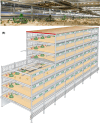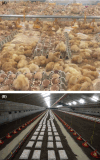Welfare of broilers on farm
- PMID: 36824680
- PMCID: PMC9941850
- DOI: 10.2903/j.efsa.2023.7788
Welfare of broilers on farm
Abstract
This Scientific Opinion considers the welfare of domestic fowl (Gallus gallus) related to the production of meat (broilers) and includes the keeping of day-old chicks, broiler breeders, and broiler chickens. Currently used husbandry systems in the EU are described. Overall, 19 highly relevant welfare consequences (WCs) were identified based on severity, duration and frequency of occurrence: 'bone lesions', 'cold stress', 'gastro-enteric disorders', 'group stress', 'handling stress', 'heat stress', 'isolation stress', 'inability to perform comfort behaviour', 'inability to perform exploratory or foraging behaviour', 'inability to avoid unwanted sexual behaviour', 'locomotory disorders', 'prolonged hunger', 'prolonged thirst', 'predation stress', 'restriction of movement', 'resting problems', 'sensory under- and overstimulation', 'soft tissue and integument damage' and 'umbilical disorders'. These WCs and their animal-based measures (ABMs) that can identify them are described in detail. A variety of hazards related to the different husbandry systems were identified as well as ABMs for assessing the different WCs. Measures to prevent or correct the hazards and/or mitigate each of the WCs are listed. Recommendations are provided on quantitative or qualitative criteria to answer specific questions on the welfare of broilers and related to genetic selection, temperature, feed and water restriction, use of cages, light, air quality and mutilations in breeders such as beak trimming, de-toeing and comb dubbing. In addition, minimal requirements (e.g. stocking density, group size, nests, provision of litter, perches and platforms, drinkers and feeders, of covered veranda and outdoor range) for an enclosure for keeping broiler chickens (fast-growing, slower-growing and broiler breeders) are recommended. Finally, 'total mortality', 'wounds', 'carcass condemnation' and 'footpad dermatitis' are proposed as indicators for monitoring at slaughter the welfare of broilers on-farm.
Keywords: animal‐based measures; broilers; end the cage age; husbandry systems; mutilations; on farm welfare; welfare consequences.
© 2023 European Food Safety Authority. EFSA Journal published by Wiley‐VCH GmbH on behalf of European Food Safety Authority.
Figures

A = total space (area) including a = space covered, with r = being the radius of a broiler chicken and R being the radius added to reflect the interindividual distance D/2 since values for interindividual distances were divided by two birds.














Four values (shown in pink with grey certainty ranges) were obtained by EKE. A linear relationship between increasing space allowances (kg/m2) and % time walking is assumed (pink line) to interpolate the EKE results. The red distribution on the right‐hand side of the plot represents the variability in % time walking expected in a population of broilers placed in a barn with highly restricted space (e.g. minimal allowed space or high stocking densities). No data were available to describe the variability in % time walking expected in a population of broilers placed in a barn with unrestricted access to space (low stocking density).

Three values (shown in pink with grey certainty ranges) were obtained by EKE. A stepwise linear relationship between increasing space allowances (kg/m2) and average FPD score is assumed (pink line) to interpolate the EKE results. The red, vertical distribution on the right‐hand side of the plot represents the variability in the average FPD score expected in a population of broilers placed in a barn with highly restricted space (e.g. minimal allowed space).




References
-
- Adcock SJJ, 2021. Early life painful procedures: long‐term consequences and implications for farm animal welfare. Frontiers in Animal Science, 2. 10.3389/fanim.2021.759522 - DOI
-
- Adler C, Schmithausen AJ, Trimborn M, Heitmann S, Spindler B, Tiemann I, Kemper N and Büscher W, 2021. Effects of a partially perforated flooring system on ammonia emissions in broiler housing—conflict of objectives between animal welfare and environment? Animals, 11, 707. 10.3390/ani11030707 - DOI - PMC - PubMed
LinkOut - more resources
Full Text Sources
